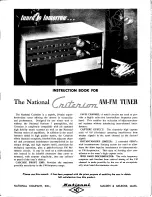
38
Sabine 2.4 GHz Smart Spectrum
®
Wireless
© 2007 Sabine, Inc.
13. REMOTE CONTROL OPERATION
13.1. Overview
In many circumstances you will adjust and control your Sabine SWM7000
wireless microphone system using the front panel controls, as outlined in
previous sections of this operating guide. In circumstances where an en-
hanced level of control over a single receiver is desired, or to enable simulta-
neous computer-based control of multiple receivers, you will need to install
(on either a laptop or desktop computer) the free Sabine SWM Remote Control
Software included with your system. Only receivers may be remotely con-
trolled; handheld and belt pack transmitters cannot be remotely controlled.
For online instructions for any function in the software, you may also refer to the
Help menu.
13.1.1. Single vs. Multiple Receiver Control
All SWM7000 series receivers have an RS-232 9-pin serial COMM Port and a
USB port. Thus, any single receiver can be controlled remotely. Control over
multiple receivers from a single computer is possible only with ND-series
receivers (SW71-NDR and SW72-NDR). These units have additional RS-485
network connections (RJ-45 jacks) for daisy-chain connection from one re-
ceiver to the next. Up to 35 receivers (70 transmission channels if all receivers
are 2-channel) may be connected in this network, all under the control of a
single computer. Single- and dual-channel receivers can be mixed in the same
network. The first receiver in such a network can be connected to the computer
via an RS-232 9-pin serial cable or USB cable. The remaining units connect
via an RS-485 cable.
NOTE: It is not possible to upgrade/retrofit a standard receiver to make it an
ND-series unit.
13.1.2 Features & Controls Added Software
All front panel controls and displays are duplicated in the software. In addi-
tion, a deeper level of software control over receiver operation is enabled.
These new controls are complete and independent for each transmission/
reception channel, meaning there are two sets of controls for dual channel
receivers. These controls and displays include:
•
Parametric filter access and control. FBX filters can be changed to
parametric filters, and their width, depth, and frequency can be adjusted.
Changes can be made at any time, both before and after FBX filters
have been set. Parametric and FBX filters can be mixed in any combi-
nation, totaling 10 for each receiver channel.
•
Adjustable FBX parameter control. Maximum depth of FBX filters can
be adjusted globally; filter width can be adjusted globally or individually.
Two controls, Sensitivity and Persistence, can be tweaked to tailor the
operation of automatic FBX filter placement to match the audio pro-
gram. Proper settings will optimize the balance between false filtering
and delayed response to feedback (the factory default settings should
operate excellently in the vast majority of conditions and may never
need to be changed).
•
Control over balance of FBX Fixed and Dynamic filters. Any FBX filter
can be set to be either fixed or dynamic.
•
Adjustable high and low cut filters. (Software only) High Cut Filter, user
controllable between 3 KHz and 20 KHz, 12 dB/octave roll-off; Low Cut
Filter user controllable between 20 Hz and 1 KHz, 12 dB/octave roll-off.
•
Additional compressor controls. Aside from adjustments for ratio,
threshold, and attack (which duplicate front panel controls), the Remote
Software provides control of compressor release time and knee. The
effect of compression on the output signal as a function of input signal
strength and parameter settings is displayed in Sabine’s unique dy-
namic ColorComp graph, in addition to the traditional opposing-meter
indicators.
Remote Control Operation
NOTE: Only SW72-NDR receivers
have a USB port. You can use a USB
to RS-232 9-pin adaptor for the
SW71-R and SW72-R units if you
need to use USB. . Go to Sabine.com
for a list of suggested adapters.
















































